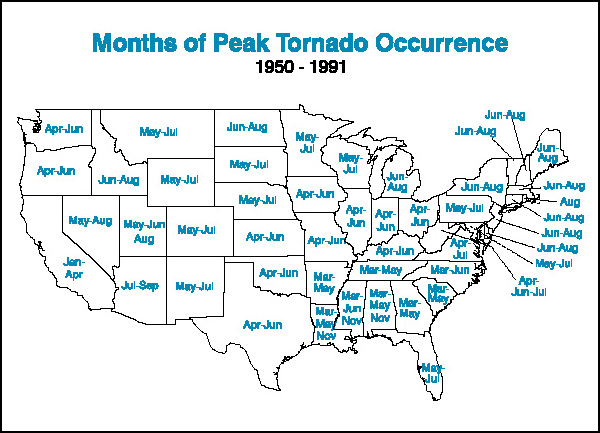What
is
a
tornado?
Tornadoes are massive columns of
rapidly rotating air that form during severe thunderstorms. They are
characterized by strong winds and are sometimes accompanied by
hailstorms and flooding. Wind speeds in a tornado can range anywhere
from 40 miles per hour to over three hundred miles per hour. Tornadoes
are classified
based on their wind speeds and are ranked from F0 (slowest speeds) to
F5 (highest speeds). This classification system was created in the
1970s by Dr. Theodore Fujita, a scientist working at the University of
Chicago. Dr. Fujita based his classification on the amount of damage
done to an area by the tornado; the more damage done by the tornado,
the highber its classification and therefore its wind speeds. This is
not without problems; basing the strength of a tornado solely on the
damage done could mean that a tornado that should be ranked as an F5
ends up with a much lower raking while one that should be ranked as an
F3 gets a much higher ranking.. The most well-known area where
tornadoes form is a region
of the American Midwest known as Tornado Alley; this region extends
from northern Texas up through Oklahoma and Nebraska, with extensions
into Colorado, Iowa and Minnesota.

However, tornadoes are not exclusive to this area; while the most tornadoes are reported here, tornadoes can form anywhere in the US and in the world. For example, in May of 1985 27 tornadoes touched down in Pennsylvania and Ohio, causing several million dollars worth of damage and injuring many people. The most frequent times of tornado formation vary by region; generally it occurs during the spring and summer months, although tornadoes can form at any time during the year.

http://www.nssl.noaa.gov/edu/safety/guideimg/pic12.jpg

http://www.oar.noaa.gov/spotlite/archive/spot_climaology.html
However, tornadoes are not exclusive to this area; while the most tornadoes are reported here, tornadoes can form anywhere in the US and in the world. For example, in May of 1985 27 tornadoes touched down in Pennsylvania and Ohio, causing several million dollars worth of damage and injuring many people. The most frequent times of tornado formation vary by region; generally it occurs during the spring and summer months, although tornadoes can form at any time during the year.

http://www.nssl.noaa.gov/edu/safety/guideimg/pic12.jpg